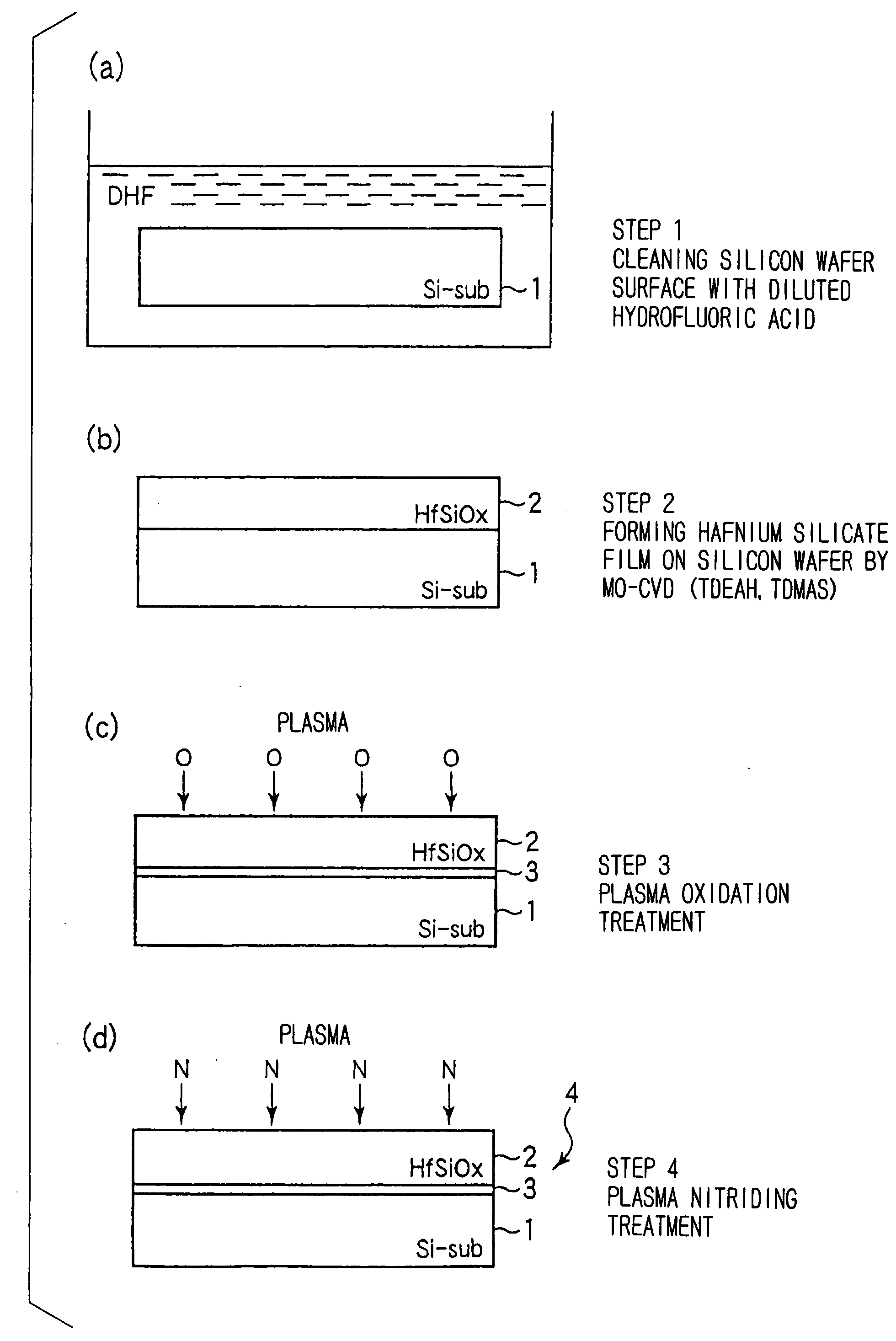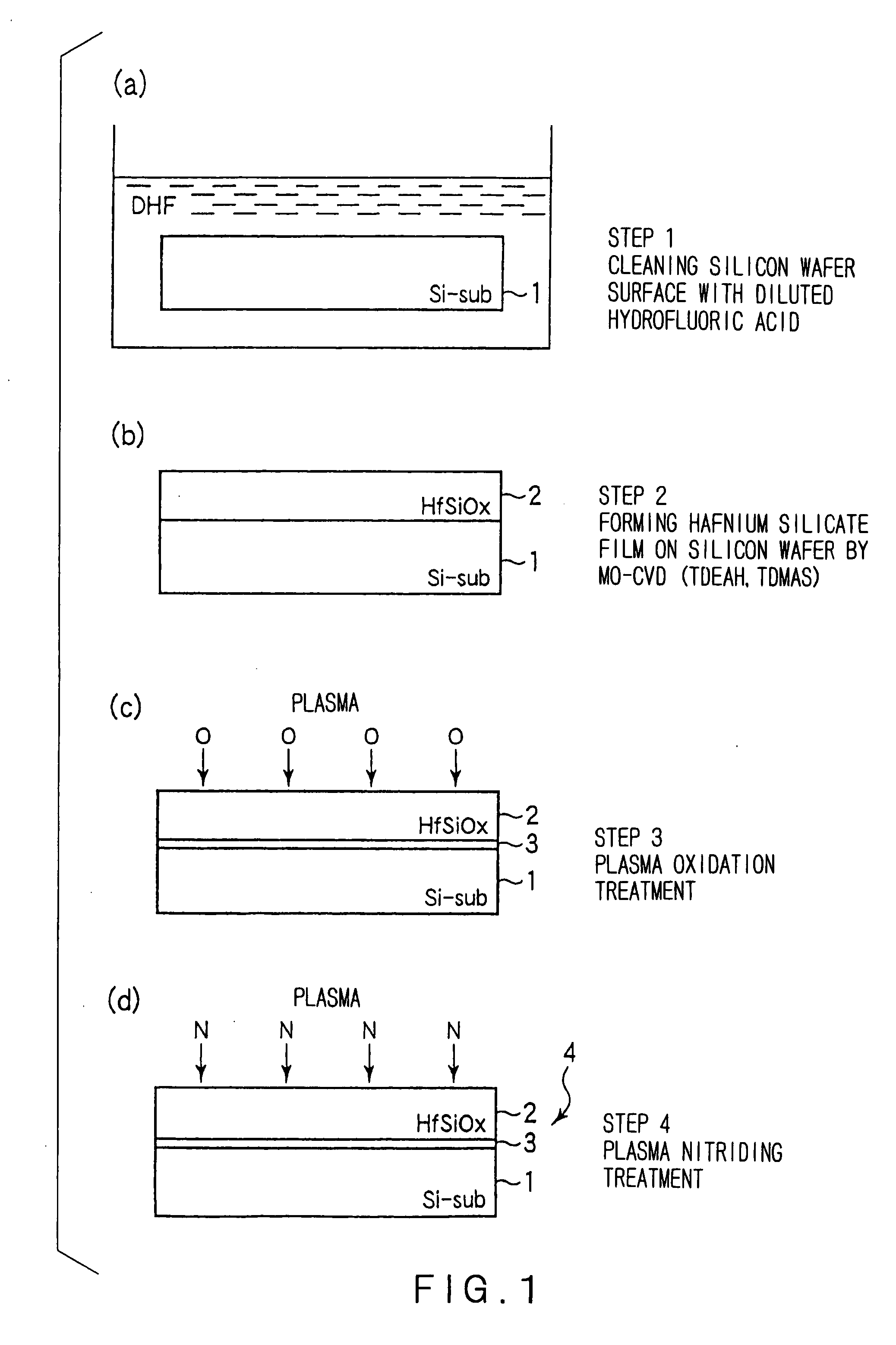Formation of Gate Insulation Film
a gate insulation and film technology, applied in the field of gate insulation film formation, can solve the problems of insufficient film quality, difficult to form a favorable interface with underlying silicon, defects or impurities, etc., and achieve the effect of improving quality, easy uniform adsorption, and small surface roughness of gate insulation film
- Summary
- Abstract
- Description
- Claims
- Application Information
AI Technical Summary
Benefits of technology
Problems solved by technology
Method used
Image
Examples
first embodiment
[0054]FIG. 1 is a process chart for explaining the method of forming a gate insulation film according to a first embodiment of the invention.
[0055]At first, in this embodiment, as shown in FIG. 1(a), a silicon wafer 1 is dipped, for example, in a diluted hydrofluoric acid (DHF) solution, thereby cleaning the surface of the silicon wafer 1 such that substantially no oxygen is present on the surface (step 1). As the diluted hydrofluoric acid, 1% hydrofluoric acid (HF content: 0.5 vol %) may be used and the treatment is applied, for example, at a room temperature for 1 to 3 minutes.
[0056]Then, as shown in FIG. 1(b), a hafnium silicate (HfSiOx) film 2 is formed by CVD (MO-CVD) using an organic metal material (step 2). In this case, a hafnium raw material, a silicon raw material, and an oxidizing agent are used as raw materials for the film formation. In the present embodiment, an amide type organic hafnium compound, for example, TDEAH (tetrakisdiethylaminohafnium) is used as the hafnium...
second embodiment
[0120]FIGS. 12A to 12E are views for explaining steps of forming a gate insulation film according to a second embodiment of the present invention.
[0121]In the present embodiment, as shown in FIG. 12A, first, a silicon wafer 201 is dipped, for example, in a diluted hydrofluoric acid (DHF) solution thereby cleaning the surface of the silicon wafer 201 such that oxygen is not substantially present on the surface (step 11) in the same manner as in the first embodiment.
[0122]Then, as shown in FIG. 12B, a base film 202 comprising a silicon oxide (SiO2) film or a silicon oxynitride (SiON) film is formed on the cleaned surface of the silicon wafer 201 (step 12). Although the film forming method in this case is not restricted, UV-ray excited radical oxidation treatment or UV-ray excited radical oxynitriding treatment is preferred since the film can be formed at a low temperature in a short time and gives no damages to the underlying layer. The film forming method may be an oxidation treatmen...
PUM
| Property | Measurement | Unit |
|---|---|---|
| Temperature | aaaaa | aaaaa |
| Temperature | aaaaa | aaaaa |
| Thickness | aaaaa | aaaaa |
Abstract
Description
Claims
Application Information
 Login to View More
Login to View More - R&D
- Intellectual Property
- Life Sciences
- Materials
- Tech Scout
- Unparalleled Data Quality
- Higher Quality Content
- 60% Fewer Hallucinations
Browse by: Latest US Patents, China's latest patents, Technical Efficacy Thesaurus, Application Domain, Technology Topic, Popular Technical Reports.
© 2025 PatSnap. All rights reserved.Legal|Privacy policy|Modern Slavery Act Transparency Statement|Sitemap|About US| Contact US: help@patsnap.com



